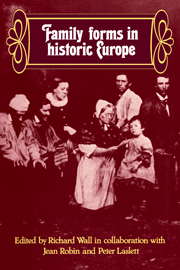Book contents
- Frontmatter
- Contents
- List of contributors
- Preface
- 1 Introduction
- 2 Two kinds of pre-industrial household formation system
- 3 ‘A large family: the peasant's greatest wealth’: serf households in Mishino, Russia, 1814–1858
- 4 The peasant family as an economic unit in the Polish feudal economy of the eighteenth century
- 5 The familial contexts of early childhood in Baltic serf society
- 6 Estonian households in the seventeenth and eighteenth centuries
- 7 Family and familia in early-medieval Bavaria
- 8 The property and kin relationships of retired farmers in northern and central Europe
- 9 Pre-industrial household structure in Hungary
- 10 The reconstruction of the family life course: theoretical problems and empirical results
- 11 The changing household: Austrian household structure from the seventeenth to the early twentieth century
- 12 Does owning real property influence the form of the household? An example from rural West Flanders
- 13 The evolving household: the case of Lampernisse, West Flanders
- 14 The composition of households in a population of 6 men to 10 women: south-east Bruges in 1814
- 15 The importance of women in an urban environment: the example of the Rheims household at the beginning of the Industrial Revolution
- 16 The household: demographic and economic change in England, 1650–1970
- 17 Family and household as work group and kin group: areas of traditional Europe compared
- References
- Index
12 - Does owning real property influence the form of the household? An example from rural West Flanders
Published online by Cambridge University Press: 05 November 2011
- Frontmatter
- Contents
- List of contributors
- Preface
- 1 Introduction
- 2 Two kinds of pre-industrial household formation system
- 3 ‘A large family: the peasant's greatest wealth’: serf households in Mishino, Russia, 1814–1858
- 4 The peasant family as an economic unit in the Polish feudal economy of the eighteenth century
- 5 The familial contexts of early childhood in Baltic serf society
- 6 Estonian households in the seventeenth and eighteenth centuries
- 7 Family and familia in early-medieval Bavaria
- 8 The property and kin relationships of retired farmers in northern and central Europe
- 9 Pre-industrial household structure in Hungary
- 10 The reconstruction of the family life course: theoretical problems and empirical results
- 11 The changing household: Austrian household structure from the seventeenth to the early twentieth century
- 12 Does owning real property influence the form of the household? An example from rural West Flanders
- 13 The evolving household: the case of Lampernisse, West Flanders
- 14 The composition of households in a population of 6 men to 10 women: south-east Bruges in 1814
- 15 The importance of women in an urban environment: the example of the Rheims household at the beginning of the Industrial Revolution
- 16 The household: demographic and economic change in England, 1650–1970
- 17 Family and household as work group and kin group: areas of traditional Europe compared
- References
- Index
Summary
Marriage and inheritance
In a paper written in 1972 Lutz Berkner listed the factors that might prevent inheritance customs from influencing the form of the household. Some factors made inheritance lore inoperative, for example if the family had no property or only ‘movables’, in which case there would be no link between their possession and a particular residence; or if land was held on a temporary lease. On the other hand, there were certain factors such as the development cycle of the household and the property arrangements surrounding marriage which might simply conceal the effect of inheritance. When to all this has to be added differences among inheritance law, custom, and practice, it becomes a very difficult matter to predict what forms of household might underlie a particular inheritance system. Indeed, in a more recent paper, written jointly with Franklin Mendels, Berkner has specifically identified an area where an egalitarian inheritance system had little effect on the partibility of land, and in turn on demographic and household patterns, because the nature of the local economy required large farms. This area comprised the polders of West Flanders.
So far, however, the arguments have been advanced in the absence of hard data on the structure of the household, and it seems worth while to try and establish whether there is a particular form of household that one might associate with rural West Flanders. For this purpose we will divide the households not only by the occupation of the head but according to whether they were owner-occupiers or tenants.
- Type
- Chapter
- Information
- Family Forms in Historic Europe , pp. 379 - 408Publisher: Cambridge University PressPrint publication year: 1983
- 4
- Cited by



